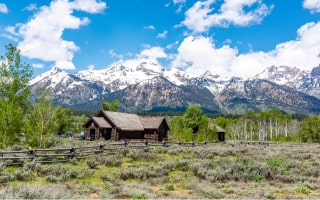How to Access Property Records in Wyoming

There are 581,381 residents in Wyoming with 278,595 homes, meaning the state produces vast amounts of property records yearly. Wyoming property records are essential to the local real estate market, private companies, and other property-related businesses. They are created by attorneys, the courts, realtors, title companies, appraisers, insurance agents, local government, and others.
Because property records are public records, anyone can search for them and make copies. Although you may have to hunt for what you need, plenty of options are available. Try the methods below to find property records.
Government Sources
You might think all property records would be in the same location, but that is not true. Instead, various government offices, private companies, and the courts maintain them.
For example, if you need to file a new deed in Wyoming, you must visit the recorder's or county clerk's office, depending on your county. If you live in Albany County, you can find more information about that on their website.
The local county assessor's office is responsible for assessing all property and setting tax rates. The county clerk's office sends out tax bills and collects payments. The Wyoming Department of Revenue oversees all local tax officials and sets tax laws.
Each city building planning office issues building permits to homeowners and contractors who want to build, demolish, or renovate a structure. To learn more about building codes and building permits in Cody, Wyoming, check out their website.
Over time, property records become massive and difficult to store. Many states, like Wyoming, move older records into archives to accommodate newer ones. The Wyoming State Archives is the repository for all older land records. They offer an online database where you can perform a property history search for historical property records.
![]() Online
Online
Some counties put their records online so people can search there to find them. To help get you started, here are a few county websites.
![]() In Person
In Person
Part of the recorder's office responsibilities is to provide easy access to public property records. During regular business hours, visitors can request records, and a small fee can be charged for certified copies.
Use this state-prepared list to find the county clerk or recorder's office you need when searching for public property records.
![]() Commercial Sources
Commercial Sources
Commercial services make it easy to find property and related records quickly and easily, saving you much time. When signing up, you may also receive access to records beyond what is present in public records. PropertyChecker.com offers nationwide property searches. Using PropertyChecker, you can search by property address, parcel ID, owner's name, phone, or email, and you can save time by running unlimited statewide or local searches 24/7. Instead of visiting multiple websites or visiting local government offices, you can find all the data points you need in one comprehensive report.
What Information Can You Find in Wyoming Property Records?
A property history search reveals a lot about a property. Some of the information may surprise you. You might have to dig deep, but you can learn much about a property. Some records contain a lot of information, and others less.
Some of the things that a property history search may reveal include:
-
Liens
-
Tax Records
-
Ownership History
-
Mortgage / Loan Records
-
Foreclosures
-
Plat Maps
-
Easements / Conveyances
-
Property Details
-
Zoning
-
Building Permits
-
Boundary Lines
-
Assessed Values
-
Deeds
-
And More!
What Are Property Records?

Wyoming property records are official documents, forms, and reports that contain valuable information about real property and its owners. There are many different types, each with various details. Some perform functions like deeds and building permits, and others, like appraisals, are simply informational.
Wyoming views land records as maps, plats, surveys, and other similar documents pertaining to real property. The Wyoming Office of State Lands and Investments has information about land records and how to obtain them.
Wyoming property records are vaster and contain much more detailed information than just maps and surveys.
Types of Property Records in Wyoming
Property records come in all shapes and sizes. It's essential to gather all types to fully understand the history of the property and all its facets. The most common types of property records found in Wyoming are:
Deeds and Conveyance Records
Deeds are the most common type of property records. They not only transfer property from one person to another but also verify the title of ownership. Deeds are recorded, filed, and maintained by each county's recorder or clerk's office.
All parties must sign deeds, and a notary must witness them. Some of the information contained in deeds includes:
- Name of the Seller/Grantor and Buyer/Grantee.
- A detailed description of the property.
- Maps and plats along with boundaries and sometimes surveys showing the acreage and edges of the property.
- Conveyance language explaining the ownership transfer from one person or entity to another.
- Notarization and execution are at the bottom, where everyone signs to make it legal.
Much of the language contained in deeds refers to the warranty implied or specified and the conveyance of the land from one or more parties to another.
Property Tax Records
Property taxes are the primary funding source for local government, schools, water/sewer services, road maintenance, and emergency services like fire, police, and ambulances.
The average effective property tax rate in Wyoming is 0.55. Although the tax rate is low, on average, homeowners pay around $5,194 per year in property taxes. The local county assessor assigns tax rates to each home in its jurisdiction, and the Wyoming Department of Revenue oversees local tax officials.
Property tax records in Wyoming contain information such as:
- Tax Rate - Each property record should contain the tax rate used to calculate the total taxes. The rate is a sum of all the taxing authorities' rates within a taxing jurisdiction.
- Assessed Value - The record will show the property's assessed value determined by the local assessor.
- Due Dates - The document will show the property taxes' deadlines as the tax collector advises.
- Payment Methods - Tax statements usually outline how property owners can contribute towards their taxes.
- Property Details - The record must show the address and other details of the property, such as the owner's name.
- Calculations - The statement may show a breakdown of the tax calculations.
using our property tax calculator.
Building Permits and Regulations in Wyoming
Cities and towns handle local building permits. If you want to build a new house, knock down an old one, or renovate an existing property, you first need to apply for a building permit. You can do so with the building planning office in your town. For more information on Wyoming building codes, click here.
Property Liens and Encumbrances in Wyoming
During your property history search, you will come across liens. These are encumbrances that can negatively affect a property and its owners. Liens appear in public property records. Too many liens in proportion to the home's equity indicate serious financial issues. There are two main types of liens: voluntary and involuntary.
Voluntary Liens
Voluntary liens are those over which you have control. You can choose to put your house up for collateral when borrowing money. The lender puts a lien on the house to protect themselves in case you default on the loan. Even voluntary liens can lead to foreclosure and the loss of your home.
-
Mortgage Liens - Mortgage liens are associated with mortgages and home equity loans. The lender places a lien on the home, and if you are three months late on your payments, the lender can foreclose and sell your house to recover their money.
Wyoming mortgages will contain the following information:
- Definitions - The documents will show definitions of terms used in the contract.
- Property Details - The record may show a detailed property description, such as its address, legal description, and any identifying information.
- Names of the Parties - These include the borrower (mortgagor) and the lender (mortgagee)
- Mortgage Terms - These are the specific terms and conditions of the loan, such as the loan amount, interest rate, repayment schedule, and maturity date.
- Recording Information - includes details about when and where the mortgage document was recorded.
Involuntary Liens
Involuntary liens are, just as they sound, against your will. You have no control over them. If you fail to pay a debt, the creditor or government office can impose a lien and then, soon after, foreclose and sell your property to get back what you owe.
- Mechanic's Liens - Contractors, subcontractors, architects, laborers, landscapers, and material suppliers can use a mechanic's lien to get paid if you don't pay them for the work they perform on your property. They must sue you in court to enforce the lien.
- Tax Liens - If you don't pay your annual property taxes, the county tax assessor will impose a tax lien and eventually foreclose and sell your property at auction for less than fair market value to pay off the back taxes.
- Judgment Liens - Creditors can use judgment liens to recoup their losses. They first must sue you in court, and then, if they win, they can foreclose and sell your house to get their money back.
The Process of Property Liens in Wyoming
The process of property liens in the state differs depending on the type of lien the claimant files. The following steps can guide property owners into filing a Mechanics' lien in the state:
- Individuals must ensure they send the correct preliminary notices before filing the lien. The prior notice deadline is 30 days after the first days of proving materials or labor. In addition, they must send a notice of intent to lien at least 20 days before filing it.
- The lien form should contain information such as the property owner's name, a description of the property, details about the labor or supplies provided, the work or supply dates, and other relevant information about the job.
- The next step is filing the lien. Individuals must record all Mechanics' liens with the County Clerk. They may attach a copy of their contract, invoice, and licenses to support their claim. The deadline for filing the lien is 120 days from the last day of providing labor or materials. The claimant must pay a recording fee and use the approved filing methods during filing.
- After filing, the claimant must send a notice to the owner informing them of the lien. The deadline for filing the lien is 30 days after the filing, and it must be sent to anyone who is registered as a property owner.
- The claimant has 180 days to enforce the lien.
Easements and Covenants
Deeds often come with easements or covenants. These add-ons dictate specific ways you can use a property. Easements are rights of way that allow a company or person to access the property without asking the owner. An example might be an oil company that has rigs on private land. They can maintain the rigs for as long as the easement exists.
Covenants are rules about how owners can use the land. These are common in gated communities and condos. An example would be that you cannot host a party on the common grounds.
Plats and Surveys
Surveys and plats are both types of maps. The difference between the two is that surveys have map coordinates and the boundaries of a single property. Plats, however, have the boundaries of other nearby properties.
Depending on the type of survey, the document may contain the following information:
- Date and Location of the Survey - The date the survey was conducted and the property's exact location.
- Surveyor's Certification - A statement by the licensed surveyor certifying that the survey was conducted per professional standards and regulations.
- Boundary Lines - The survey will depict the exact boundary lines of the property, often marked with monuments on the ground.
- Property Description - A comprehensive legal description of the property may include measurements, directions, and lot and block numbers.
- Adjacent Properties - Information about neighboring properties, their owners, and their boundaries, especially if they influence the surveyed property.
- Physical Features - Identification and location of physical features on or near the property, such as buildings, driveways, fences, and trees.
Property Descriptions and Boundaries in Wyoming
Every piece of real property in Wyoming has a legal description. These descriptions include natural landmarks, other defining characteristics, and map coordinates, making the property easy to find. They appear in deeds, appraisals, mortgages, tax records, etc.
Surveys measure the land to obtain boundaries and map coordinates. They are used before new construction, when installing utilities, and in boundary disputes.
Boundary disputes occur when one party believes another party is encroaching upon their land. These disputes often escalate and end up in court, where a judge must decide. The courts sometimes use surveyors to provide expert testimony to help determine who owns what.
Foreclosures
Foreclosures appear readily in property records and online sources. A foreclosure can sully an owner's financial reputation. Plus, it lowers the value of the home and makes it harder to sell. Many buyers will shy away from the hassles of dealing with a foreclosure home.
Pre-foreclosures are homes in the process of foreclosure, but they have yet to be sold at auction. There is still time to avoid a foreclosure showing up on your credit report if you sell to an investor. These investors seek pre-foreclosure homes to buy cheap and sell for a profit.
Understanding Property Ownership in Wyoming
Wyoming is a wide-open state with plenty of eye-catching views. Owning a piece of this land is quite something, but it comes with responsibilities, such as paying your mortgage, interest, and taxes on time. You should also maintain the property to maintain its value.
Many situations arise where you need to find the owner of a property. Thankfully, you can do so easily. Contact the county clerk or recorder's office and ask for the most current deed. That will have the name and address of the most recent owner.
If you want to know when a property was built, you can easily find out by contacting the local county recorder's office and asking for the first-ever building permit. You will see when it was built and who owned it.
Ownership History Records
Property changes hands in different ways. Most often, it is sold in real estate sales. Other times, it is gifted through a will or a special deed before death. Sometimes, a person will sign the deed to their house over to another person or company to pay off a debt.
What is a Chain of Title?
The chain of title is a public list of everyone who has ever owned a property, going back to the first owner. This list is documented through deeds with the recorder's office and must remain unbroken. Someone always owned the land once it was first sold.
Buying and Selling Property in Wyoming

Property records are most popular before, during, and after real estate transactions. Before the sale, the buyer, realtors, appraisers, inspectors, and others use property records to gather information about the property. During the process, more records are created to replace older ones.
Learning as much as possible when buying property in Wyoming is prudent for making an informed decision. Use property records to examine the history and learn about the value, taxes, insurance, and other key factors before making an offer.
When selling property in Wyoming, you must disclose material defects to any potential buyers. These things usually refer to asbestos, lead paint, issues with the foundation or roof, or internal systems.
You will have a mortgage if you borrow money to buy the house. Your lender will require you to purchase title insurance to protect you against anyone claiming ownership after the sale. Your title company or closing attorney will perform a property title search to avoid issues like these.
Why Property Values Are Important in Real Estate Transactions
Property values are essential information for buyers and sellers. These values change rapidly with the economy, local real estate market dips, and inflation. Other factors also affect property values. Fair market values appear in property records and other places online. They are the yardstick used to compare similar properties and determine how much a house is worth in the current market.
Tax officials and appraisers use different methods to determine a property's value. Tax assessors use special assessments to derive a value for each property within the county and set tax rates. These values do not always match the fair market value. The median home price in Wyoming is $320,546.
Appraisers use one of four methods to determine the fair market value of a property for real estate buyers, lenders, or estate planners. Typically, appraisers compare recent sales of similar homes in the past three months.
What Factors Determine Property Values in Wyoming
The following factors may explain the high property prices in some areas of Wyoming:
-
Energy Potential - Cities in Wyoming with a strong presence in the energy and resource industry, such as Gillette, may experience higher poetry values.
-
Proximity to Wilderness and Scenic Views - Properties near popular natural attractions like national parks, forests, lakes, or mountain ranges can increase in value due to their scenic beauty. For example, properties in Jackson Hole may command higher prices due to their proximity to Grand Teton National Park and Yellowstone National Park.
-
Agriculture and Ranching Potential - Wyoming's rural areas, which have fertile land for farming and ranching, may experience property values tied to agricultural productivity. For example, the ranching industry may influence towns in the state's southeastern part.
-
Access to Amenities and Services - The availability of essential amenities, such as schools, hospitals, shopping centers, and recreational facilities, can increase property records.
Maintaining and Amending Wyoming Property Records
Each recorder's or county clerk's office has its own method of doing things. However, whenever a new record arrives, they stamp it with the date, time, and code to make it easy to find later.
Property records are essential when you must prove you own the land and in other situations. Therefore, you must keep your records updated and correct. No one will know to update them automatically as things change in your life.
Some property records contain errors. You should fix them as quickly as possible. Contact the recorder's office or county clerk and ask them to fix the errors. Bring documentation to support your claim of an error.
You also must update property records when someone dies. You can do this easily by bringing the will, death certificate, and the person named in the will who inherited the land to the county recorder's office. That office will create a new deed in the beneficiary's name and help witness and notarize it.
You will want to change your property records if you get married or divorced. Bring your marriage certificate or divorce decree to the recorder's office or county clerk and ask them to update them. You may have to pay a fee for this service.
The Role of the Recorder's Office

Each Wyoming recorder's office plays a crucial role in local government. Along with a myriad of other duties, the recorder's office maintains records of land transactions, subdivisions, mineral leases, and mining claims. Anything related to real property must be filed with this office in the county where the property resides.
How to Ensure Data Privacy for Property Records
Privacy laws do not protect public property records. They are public, meaning anyone can view them or get copies. If you own property in Wyoming, your name, address, and potentially other information will appear in property records for anyone to see.
Public property records are accessible to anyone. The recorder's or county clerk's office makes it easy for people to request records in person or online. You can also access public property records through third-party and other sources.
Property records are public to promote transparency in government and prevent any one office from having too much power over the people. In addition, they preserve the public chain of title, which is the list of everyone who ever owned it. This chain is documented through deeds.
Although you cannot remove all your information from property records, you can minimize your exposure to identity theft and fraud. Contact the recorder or clerk's office and ask that they remove anything beyond your name and address from public property records.

- 1603 Capitol Avenue Suite 413,
Cheyenne, WY 82001 - (307) 318-1079
Instant Access to Wyoming Property Records
- Owner(s)
- Deed Records
- Loans & Liens
- Values
- Taxes
- Building Permits
- Purchase History
- Property Details
- And More!
Property Records Guide
- How to Access Property Records in Wyoming
- What Are Property Records?
- Types of Property Records in Wyoming
- Understanding Property Ownership in Wyoming
- Buying and Selling Property in Wyoming
- Maintaining and Amending Wyoming Property Records
- The Role of the Recorder's Office
- How to Ensure Data Privacy for Property Records
- Albany County
- Big Horn County
- Campbell County
- Carbon County
- Converse County
- Crook County
- Fremont County
- Goshen County
- Hot Springs County
- Johnson County
- Laramie County
- Lincoln County
- Natrona County
- Niobrara County
- Park County
- Platte County
- Sheridan County
- Sublette County
- Sweetwater County
- Teton County
- Uinta County
- Washakie County
- Weston County
Instant Access to Wyoming Property Records
- Owner(s)
- Deed Records
- Loans & Liens
- Values
- Taxes
- Building Permits
- Purchase History
- Property Details
- And More!
Property Records Guide
- How to Access Property Records in Wyoming
- What Are Property Records?
- Types of Property Records in Wyoming
- Understanding Property Ownership in Wyoming
- Buying and Selling Property in Wyoming
- Maintaining and Amending Wyoming Property Records
- The Role of the Recorder's Office
- How to Ensure Data Privacy for Property Records
Wyoming Property Resources
Wyoming Counties
- Albany County
- Big Horn County
- Campbell County
- Carbon County
- Converse County
- Crook County
- Fremont County
- Goshen County
- Hot Springs County
- Johnson County
- Laramie County
- Lincoln County
- Natrona County
- Niobrara County
- Park County
- Platte County
- Sheridan County
- Sublette County
- Sweetwater County
- Teton County
- Uinta County
- Washakie County
- Weston County